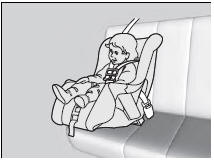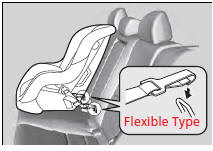 Honda Accord: Safety of Infants and Small Children
Honda Accord: Safety of Infants and Small Children
• Protecting Infants
An infant must be properly restrained in a rear-facing, reclining child seat until the infant reaches the seat maker's weight or height limit for the seat, and the infant is at least one year old.

• Positioning a rear-facing child seat
Child seats must be placed and secured in a rear seating position.
When properly installed, a rear-facing child seat may prevent the driver or a front passenger from moving their seat all the way back, or from locking their seat-back in the desired position.
It can also interfere with proper operation of the passenger's advanced front airbag system.
If this occurs, we recommend that you install the child seat directly behind the front passenger's seat, move the seat as far forward as needed, and leave it unoccupied.
Or, you may wish to get a smaller rear-facing child seat.
WARNING
Placing a rear-facing child seat in the front seat can result in serious injury or death during a crash.
Always place a rear-facing child seat in the rear seat, not the front.
Rear-facing child seats should never be installed in a forward facing position.
Always refer to the child seat manufacturer’s instructions before installation.
• Protecting Smaller Children
If a child is at least one year old and within the weight range indicated by the child seat manufacturer, the child should be properly restrained in a firmly secured forward-facing child seat.
• Forward-facing child seat placement
We strongly recommend placing a forwardfacing child seat in a rear seating position.

Placing a forward-facing child seat in the front seat can be hazardous, even with advanced front airbags that automatically turn the passenger's front airbag off. A rear seat is the safest place for a child.
WARNING
Placing a forward-facing child seat in the front seat can result in serious injury or death if the front airbag inflates.
If you must place a forward-facing child seat in front, move the vehicle seat as far back as possible, and properly restrain the child.
Educate yourself about the laws and regulations regarding child seat use where you are driving, and follow the child seat manufacturer's instructions.
Many experts recommend use of a rear-facing seat up to age two, if the child’s height and weight are appropriate for a rear-facing seat.
Selecting a Child Seat
Most child seats are LATCH-compatible (Lower Anchors and Tethers for CHildren).
Some have a rigid-type connector, while others have a flexible-type connector. Both are equally easy to use. Some existing and previously owned child seats can only be installed using the seat belt. Whichever type you choose, follow the child seat manufacturer's use and care instructions as well as the instructions in this manual.
Proper installation is key to maximizing your child's safety.
In seating positions and vehicles not equipped with LATCH, a LATCH compatible child seat can be installed using the seat belt and a top tether for added security.
This is because all child seats are required to be designed so that they can be secured with a lap belt or the lap part of a lap/shoulder belt. In addition, the child seat manufacturer may advise that a seat belt be used to attach a LATCH-compatible seat once a child reaches a specified weight. Please read the child seat owner’s manual for proper installation instructions.
• Important consideration when selecting a child seat
Make sure the child seat meets the following three requirements:
• The child seat is the correct type and size for the child.
• The child seat is the correct type for the seating position.
• The child seat is compliant with Federal Motor Vehicle Safety Standard 213 or
Canadian Motor Vehicle Safety Standard 213.
Installation of a LATCH-compatible child seat is simple.
LATCH-compatible child seats have been developed to simplify the installation process and reduce the likelihood of injuries caused by incorrect installation.
• Installing a LATCH-Compatible Child Seat
A LATCH-compatible child seat can be installed in either of the two outer rear seats.
A child seat is attached to the lower anchors with either the rigid or flexible type of connectors.

1. Locate the lower anchors under the marks.


2. Place the child seat on the vehicle seat then
attach the child seat to the lower anchors
according to the instructions that came
with the child seat.
- When installing the child seat, make sure
that the lower anchors are not
obstructed by the seat belt or any other
object.

3. Open the tether anchor cover behind the
head restraint.
4. Raise the head restraint to its highest
position, then route the tether strap
between the head restraint legs, and secure
the tether strap hook onto the anchor.
5. Tighten the tether strap as instructed by the
child seat maker.
6. Make sure the child seat is firmly secured by
rocking it forward and back and side to
side; little movement should be felt.
7. Make sure any unused seat belt that a child
can reach is buckled, the lockable retractor
is activated, and the belt is fully retracted
and locked.
For your child's safety, when using a child seat installed using the LATCH system, make sure that the seat is properly secured to the vehicle. A child seat that is not properly secured will not adequately protect a child in a crash and may cause injury to the child or other vehicle occupants.
• Installing a Child Seat with a Lap/Shoulder Seat Belt

1. Place the child seat on the vehicle seat.
2. Route the seat belt through the child seat
according to the seat maker's instructions,
and insert the latch plate into the buckle.
- Insert the latch plate fully until it clicks.

3. Slowly pull the shoulder part of the belt all
the way out until it stops. This activates the
lockable retractor.
4. Let the seat belt completely wind up into
the retractor, then try to pull it out to make
sure the retractor is locked.
- If you are able to pull the shoulder belt
out, the lockable retractor is not
activated. Pull the seat belt all the way
out, and repeat steps 2 – 4.

5. Grab the shoulder part of the seat belt near
the buckle, and pull up to remove any slack
from the lap part of the belt.
- When doing this, place your weight on
the child seat and push it into the vehicle
seat.
A child seat that is not properly secured will not adequately protect a child in a crash and may cause injury to the child or other vehicle occupants.

6. Make sure the child seat is firmly secured by
rocking it forward and back and side to
side; little movement should be felt.
7. Make sure any unused seat belt that a child
can reach is buckled, the lockable retractor
is activated, and the belt is fully retracted
and locked.
To deactivate a lockable retractor, release the buckle and allow the seat belt to wind up all the way.
• Adding Security with a Tether
A tether anchorage point is provided behind each rear seating position. A child seat that is installed with a seat belt and comes with a tether can use the tether for additional security.

1. Locate the appropriate tether anchorage point and lift the cover.

2. Raise the head restraint to its highest position, then route the tether strap through the head restraint legs. Make sure the strap is not twisted.

3. Secure the tether strap hook onto the
anchor.
4. Tighten the tether strap as instructed by the
child seat manufacturer.
Since a tether can provide additional security to the lap/shoulder seat belt installation, we recommend using a tether whenever one is available.
 Protecting Child Passengers
Protecting Child Passengers
Each year, many children are injured or killed in vehicle crashes because
they are
either unrestrained or not properly restrained. In fact, vehicle accidents are
the
number one cause of death ...
 Safety of Larger Children
Safety of Larger Children
• Protecting Larger Children
The following pages give instructions on how to check proper seat belt fit,
what kind
of booster seat to use if one is needed, and important precautions for a child ...
See also:
Winter Driving
Tires marked ‘‘M + S’’ or ‘‘All
Season’’ on the sidewall have an allweather
tread design suitable for
most winter driving conditions.
For the best performance in snowy
or icy ...
Rearview Mirror Harness Cover Base
Replacement
4-door with Automatic Dimming Rearview
Mirror
NOTE:
t Put on gloves to protect your hands.
- Wear eye protection while cutting the glass adhesive
with piano wire.
1. Remove these items:
- R ...
Rear Inner Fender Replacement
NOTE: Take care not to scratch the rear bumper or the
body.
1. Remove the screws, then remove the rear inner
fender (A) from the rear bumper (B) and the body.
2. Install the inner fender in th ...
